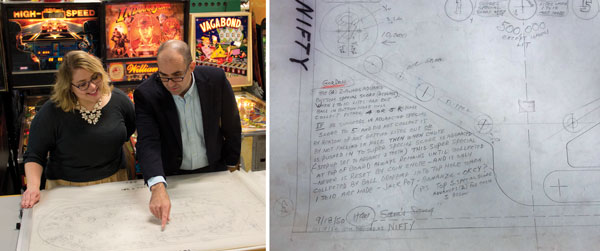News
Williams Donates Original Pinball Machine Drawings To Strong Museum
December 29, 2015
TAGS: Williams Electronics Games, Strong Museum, pinball machine, coin-op, The Strong National Museum of Play, The Williams Pinball Playfield Design Collection, Harry Williams, Gordon Horlick, Harry Mabs, Steve Kordek, Norm Clark, Barry Oursler, Mark Ritchie, Python Anghelo, Jeremy Saucier |
ROCHESTER, NY -- Former arcade manufacturing giant Williams Electronics Games Inc. has donated hundreds of original pinball design drawings to The Strong National Museum of Play in Rochester, NY. The technical illustrations, which date from 1946 through 1995, include more than 200 hand-drawn renderings of playfields and conceptual artwork.
Material making up the donation, named "The Williams Pinball Playfield Design Collection: 1946-1995," includes conceptual drawings for such games as Dynamite (1946), Williams' second pinball machine; Sunny (1947), its first game with flippers; All American Quarterback (1949); Nine Sisters (1953); Daffy Derby (1954); Magic Clock (1960); Vagabond (1962); Apollo (1967); Little Chief (1975); Joust (1983); Diner (1990); The Machine: Bride of Pinbot (1991); Indiana Jones: The Pinball Adventure (1993); and Dirty Harry (1995).
 |
EXAMINING HISTORY:At left, Jeremy Saucier, assistant director of the International Center for the History of Electronic Games, examines a drawing from the Williams Pinball Playfield Design Collection with archivist Julia Novakovic. Pictured at right is a detail from the playfield design of Williams Electronics' classic 1950 pin Nifty; shown are notes on the player and machine interfaces. |
The collection also includes original drawings by the company's founder Harry Williams, as well as Gordon Horlick, Harry Mabs, Steve Kordek, Norm Clark, Barry Oursler, Mark Ritchie and Python Anghelo.
"In terms of size, it is not a big as some of the other collections we have, like the Atari coin-op material, but it is a very significant donation," said Jeremy Saucier, assistant director for the Strong's International Center for the History of Electronic Games. "This is probably the only collection of its kind still in existence. As far as we know, there is no other collection of design materials this early on in the pinball industry."
Saucier explained that the playfield designs are nearly complete from 1947 through 1971, and include such innovative games as Vagabond, which featured the first drop target, along with the 1968 horse racing-themed Hayburners II, with three flippers. "This is the work of the designers who created the games," he said of the drawings. "They decided where the pop-ups go, where the flippers were placed." The hand-drawn images include additions and erasures that show the evolution of some of history's most popular pins.
At this writing, the institution is planning to display some of the donated material in a pinball exhibit scheduled to open early in 2016.
Established as Strong National Museum of Play in 1969 to house the collection assembled by Margaret Woodbury Strong (1897-1969), a collector and philanthropist from Rochester, NY, the institution opened in 1982. It is said to be the only collections-based museum in the world devoted solely to the history and exploration of play. The Strong now is the parent organization of the International Center for the History of Electronic Games, the National Toy Hall of Fame, the World Video Game Hall of Fame, the Brian Sutton-Smith Library and Archives of Play and the Woodbury School, and publishes the American Journal of Play thrice annually.
 |
ADVENTURE & INNOVATION:Among the design drawings recently donated to the Strong museum are those for the 1993 Williams game Indiana Jones: The Pinball Adventure (l). An early image of drop target (r.) serves as reminder of just how innovative Williams' pins were. Although second to Gottlieb in popularity, Williams earned high creativity marks. |


